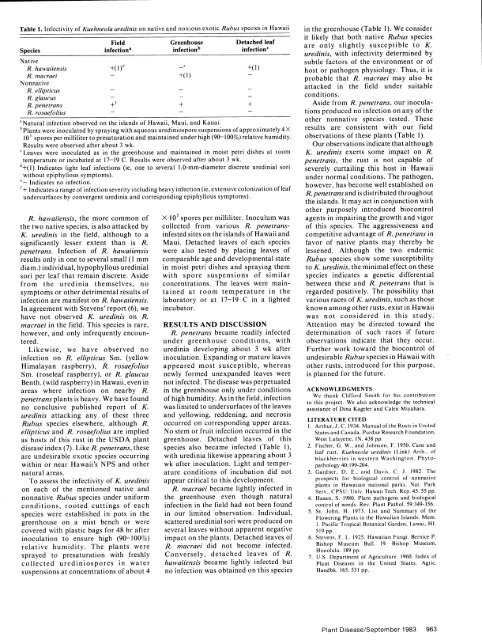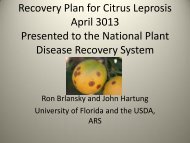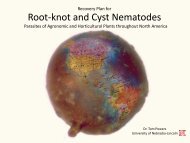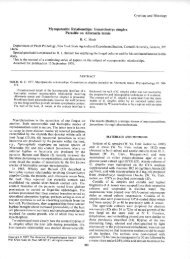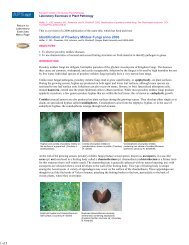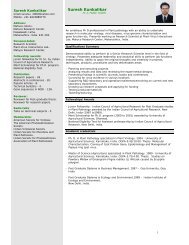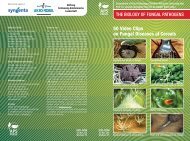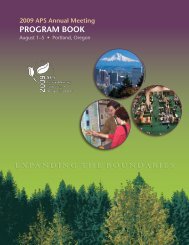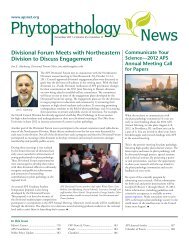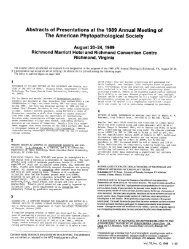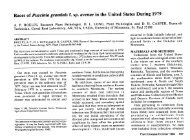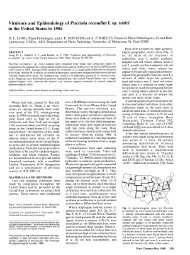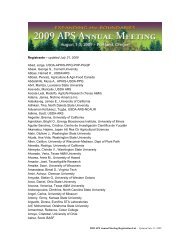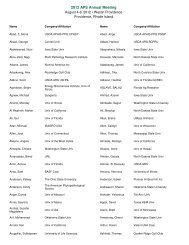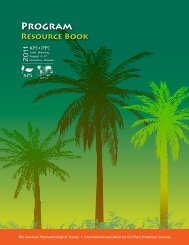Leaf Rust Caused by Kuehneola uredinis on Native and Nonnative ...
Leaf Rust Caused by Kuehneola uredinis on Native and Nonnative ...
Leaf Rust Caused by Kuehneola uredinis on Native and Nonnative ...
Create successful ePaper yourself
Turn your PDF publications into a flip-book with our unique Google optimized e-Paper software.
Table 1. Infectivity of <str<strong>on</strong>g>Kuehneola</str<strong>on</strong>g> <str<strong>on</strong>g>uredinis</str<strong>on</strong>g> <strong>on</strong> native <strong>and</strong> noxious exotic Rubus species in Hawaii in the greenhouse (Table 1). We c<strong>on</strong>sider<br />
Species<br />
Seives<br />
infecti<strong>on</strong>'<br />
Field<br />
i<str<strong>on</strong>g>uredinis</str<strong>on</strong>g>,<br />
Greenhouse<br />
infecti<strong>on</strong> b<br />
Detached leaf<br />
infecti<strong>on</strong>c<br />
it likely that both native Rubus species<br />
are <strong>on</strong>ly slightly susceptible to K.<br />
with infectivity determined <str<strong>on</strong>g>by</str<strong>on</strong>g><br />
<strong>Native</strong><br />
R. hawaiiensis<br />
N<strong>on</strong>native<br />
+(l)d _(1)<br />
subtle factors of the envir<strong>on</strong>ment or of<br />
host or pathogen physiology. Thus, it is<br />
probable that R. macraei may also be<br />
R. ellipticus<br />
R. glaucus -<br />
R. penetrans +f + +<br />
R. rosaefolius - -<br />
aNatural infecti<strong>on</strong> observed <strong>on</strong> the isl<strong>and</strong>s of Hawaii, Maui, <strong>and</strong> Kauai.<br />
bPlants were inoculated <str<strong>on</strong>g>by</str<strong>on</strong>g> spraying with aqueous urediniospore suspensi<strong>on</strong>s of approximately 4 X<br />
attacked in the field under suitable<br />
c<strong>on</strong>diti<strong>on</strong>s.<br />
Aside from R. penetrans, our inoculati<strong>on</strong>s<br />
produced no infecti<strong>on</strong> <strong>on</strong> any of the<br />
other n<strong>on</strong>native species tested. These<br />
results are c<strong>on</strong>sistent with our field<br />
10' spores per milliliter to presaturati<strong>on</strong> <strong>and</strong> maintained under high (90-100%) relative humidity.<br />
Results were observed after about 3 wk.<br />
cLeaves were inoculated as in the greenhouse <strong>and</strong> maintained in moist petri dishes at room<br />
temperature or incubated at 17-19 C. Results were observed after about 3 wk.<br />
d+(l) Indicates light leaf infecti<strong>on</strong>s (ie, <strong>on</strong>e to several 1.0-mm-diameter discrete uredinial sori<br />
without epiphyllous symptoms).<br />
Indicates no infecti<strong>on</strong>.<br />
observati<strong>on</strong>s of these plants (Table 1).<br />
Our observati<strong>on</strong>s indicate that although<br />
K. <str<strong>on</strong>g>uredinis</str<strong>on</strong>g> exerts some impact <strong>on</strong> R.<br />
penetrans, the rust is not capable of<br />
severely curtailing this host in Hawaii<br />
under normal c<strong>on</strong>diti<strong>on</strong>s. The pathogen,<br />
however, has become well established <strong>on</strong><br />
+ Indicates a range of infecti<strong>on</strong> severity including heavy infecti<strong>on</strong> (ie, extensive col<strong>on</strong>izati<strong>on</strong> of leaf<br />
undersurfaces <str<strong>on</strong>g>by</str<strong>on</strong>g> c<strong>on</strong>vergent uredinia <strong>and</strong> corresp<strong>on</strong>ding epiphyllous symptoms).<br />
R. penetrans <strong>and</strong> is distributed throughout<br />
the Rh pnrans isl<strong>and</strong>s. It may <strong>and</strong> act diti is in c<strong>on</strong>juncti<strong>on</strong> uted th with<br />
R. hawaiiensis, the more comm<strong>on</strong> of<br />
the two native species, is also attacked <str<strong>on</strong>g>by</str<strong>on</strong>g><br />
K. <str<strong>on</strong>g>uredinis</str<strong>on</strong>g> in the field, although to a<br />
significantly lesser extent than is R.<br />
penetrans. Infecti<strong>on</strong> of R. hawaiiensis<br />
results <strong>on</strong>ly in <strong>on</strong>e to several small (1 mm<br />
diam.) individual, hypophyllous uredinial<br />
sori per leaf that remain discrete. Aside<br />
from the uredinia themselves, no<br />
symptoms or other detrimental results of<br />
infecti<strong>on</strong> are manifest <strong>on</strong> R. hawaiiensis.<br />
In agreement with Stevens' report (6), we<br />
have not observed K. <str<strong>on</strong>g>uredinis</str<strong>on</strong>g> <strong>on</strong> R.<br />
macraei in the field. This species is rare,<br />
however, <strong>and</strong> <strong>on</strong>ly infrequently encountered.<br />
Likewise, we have observed no<br />
infecti<strong>on</strong> <strong>on</strong> R. ellipticus Sm. (yellow<br />
Himalayan raspberry), R. rosaefolius<br />
Sm. (roseleaf raspberry), or R. glaucus<br />
Benth. (wild raspberry) in Hawaii, even in<br />
areas where infecti<strong>on</strong> <strong>on</strong> near<str<strong>on</strong>g>by</str<strong>on</strong>g> R.<br />
penetrans plants is heavy. We have found<br />
no c<strong>on</strong>clusive published report of K.<br />
<str<strong>on</strong>g>uredinis</str<strong>on</strong>g> attacking any of these three<br />
Rubus species elsewhere, although R.<br />
ellipticus <strong>and</strong> R. rosaefolius are implied<br />
as hosts of this rust in the USDA plant<br />
disease index (7). Like R. penetrans, these<br />
are secis ndeirale ocuring xotc<br />
are secis ndeirale ocuring xotc<br />
within or near Hawaii's NPS <strong>and</strong> other<br />
natural areas.<br />
To assess the infectivity of K. <str<strong>on</strong>g>uredinis</str<strong>on</strong>g><br />
<strong>on</strong> each of the menti<strong>on</strong>ed native <strong>and</strong><br />
n<strong>on</strong>native Rubus species under uniform<br />
c<strong>on</strong>diti<strong>on</strong>s, rooted cuttings of each<br />
species were established in pots in the<br />
greenhouse <strong>on</strong> a mist bench or were<br />
covered with plastic bags for 48 hr after<br />
X 10 spores per milliliter. Inoculum was<br />
collected from various R. penetransinfested<br />
sites <strong>on</strong> the isl<strong>and</strong>s of Hawaii <strong>and</strong><br />
Maui. Detached leaves of each species<br />
were also tested <str<strong>on</strong>g>by</str<strong>on</strong>g> placing leaves of<br />
comparable age <strong>and</strong> developmental state<br />
in moist petri dishes <strong>and</strong> spraying them<br />
with spore suspensi<strong>on</strong>s of similar<br />
c<strong>on</strong>centrati<strong>on</strong>s. The leaves were maintained<br />
at room temperature in the<br />
laboratory or at 17-19 C in a lighted<br />
incubator,<br />
RESULTS AND DISCUSSION<br />
R. penetrans became readily infected<br />
under greenhouse c<strong>on</strong>diti<strong>on</strong>s, with<br />
uredinia developing about 3 wk after<br />
inoculati<strong>on</strong>. Exp<strong>and</strong>ing or mature leaves<br />
appeared most susceptible, whereas<br />
newly formed unexp<strong>and</strong>ed leaves were<br />
not infected. The disease was perpetuated<br />
in the greenhouse <strong>on</strong>ly under c<strong>on</strong>diti<strong>on</strong>s<br />
of high humidity. As in the field, infecti<strong>on</strong><br />
was limited to undersurfaces of the leaves<br />
<strong>and</strong> yellowing, reddening, <strong>and</strong> necrosis<br />
occurred <strong>on</strong> corresp<strong>on</strong>ding upper areas.<br />
No stem or fruit infecti<strong>on</strong> occurred in the<br />
greenhouse. Detached leaves of this<br />
species also became infected (Table 1),<br />
withureini liewie apeaingabot 3<br />
withureini liewie apeaingabot 3<br />
wk after inoculati<strong>on</strong>. Light <strong>and</strong> temperature<br />
c<strong>on</strong>diti<strong>on</strong>s of incubati<strong>on</strong> did not<br />
appear critical to this development,<br />
R. macraei became lightly infected in<br />
the greenhouse even though natural<br />
infecti<strong>on</strong> in the field had not been found<br />
in our limited observati<strong>on</strong>. Individual,<br />
scattered uredinial s<strong>on</strong>iwere produced <strong>on</strong><br />
several leaves without apparent negative<br />
other purposely introduced bioc<strong>on</strong>trol<br />
agents in impairing the growth <strong>and</strong> vigor<br />
of this species. The aggressiveness <strong>and</strong><br />
competitive advantage of R. penetrans in<br />
favor of native plants may there<str<strong>on</strong>g>by</str<strong>on</strong>g> be<br />
lessened. Although the two endemic<br />
Rubus species show some susceptibility<br />
to K. <str<strong>on</strong>g>uredinis</str<strong>on</strong>g>, the minimal effect <strong>on</strong> these<br />
species indicates a genetic differential<br />
between these <strong>and</strong> R. penetrans that is<br />
regarded positively. The possibility that<br />
various races of K. <str<strong>on</strong>g>uredinis</str<strong>on</strong>g>, such as those<br />
known am<strong>on</strong>g other rusts, exist in Hawaii<br />
was not c<strong>on</strong>sidered in this study.<br />
Attenti<strong>on</strong> may be directed toward the<br />
determinati<strong>on</strong> of such races if future<br />
observati<strong>on</strong>s indicate that they occur.<br />
Further work toward the bioc<strong>on</strong>trol of<br />
undesirable Rubus species in Hawaii with<br />
other rusts, introduced for this purpose,<br />
is planned for the future.<br />
ACKNOWLEDGMENTS<br />
We thank Clifford Smith for his c<strong>on</strong>tributi<strong>on</strong><br />
to this project. We also acknowledge the technical<br />
assistance of D ea Kageler <strong>and</strong> Calen Miyahara.<br />
LITERATURE CITED<br />
States <strong>and</strong> Canada. Purdue Research Foundati<strong>on</strong>.<br />
West Lafayette, IN. 438 pp.<br />
2. Fischer, 0. W., <strong>and</strong> Johns<strong>on</strong>. F. 1950. Cane <strong>and</strong><br />
leaf rust, <str<strong>on</strong>g>Kuehneola</str<strong>on</strong>g> uredini~s (link) Arth.. of<br />
blackberries in western Washingt<strong>on</strong>. Phyto-<br />
pathology 40:199-204.<br />
3. Gardner, D. E., <strong>and</strong> Davis, C. J. 1982. The<br />
prospects for biological c<strong>on</strong>trol of n<strong>on</strong>native<br />
plants in Hawaiian nati<strong>on</strong>al parks. Nat. Park<br />
Serv., CPSU/ Univ. Hawaii Tech. Rep. 45. 55 pp.<br />
4. Hasan, 5. 1980. Plant pathogens <strong>and</strong> biological<br />
c<strong>on</strong>trol of weeds. Rev. Plant Pathol. 59:349-356.<br />
5. St. John, H. 1973. List <strong>and</strong> Summary of the<br />
Flowering Plants in the Hawaiian Isl<strong>and</strong>s. Mem.<br />
1. Pacific Tropical Botanical Garden, tLawai, HI.<br />
519 pp.<br />
inoculati<strong>on</strong> to ensure high (90-100%) impact <strong>on</strong> the plants. Detached leaves of<br />
relative humidity. The plants were R. macraei did not become infected.<br />
spraed o pesaurai<strong>on</strong>wit frshl C<strong>on</strong>erslydetche levesof .<br />
spraed wih t prsatuatin feshl C<strong>on</strong>ersly, etahed eavsofR.<br />
collected urediniospores in water hawaiiensis became lightly infected but<br />
suspensi<strong>on</strong>s at c<strong>on</strong>centrati<strong>on</strong>s of about 4 no infecti<strong>on</strong> was obtained <strong>on</strong> this species<br />
~<br />
6. Stevens, F. L. 1925. Hawaiian Fungi. Bernice P.<br />
Bishop Museum Bull. 19. Bishop Museum,<br />
H<strong>on</strong>olulu. 189 pp.<br />
U. us. Department of Agriculture. 1960. index of<br />
Plant Diseases in the United States. Agric.<br />
H<strong>and</strong>bk. 165. 531 pp.<br />
Plant Disease/September 1983 963


